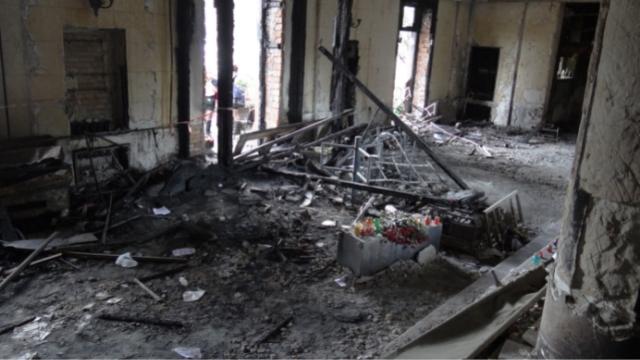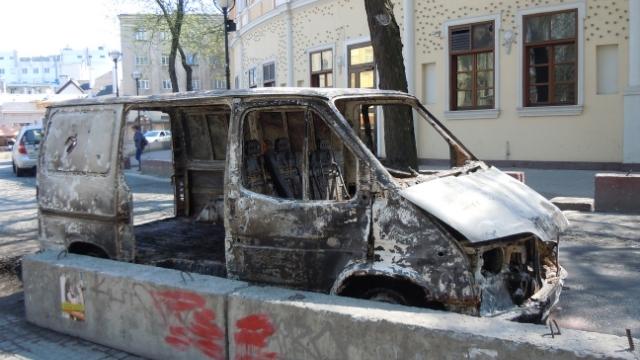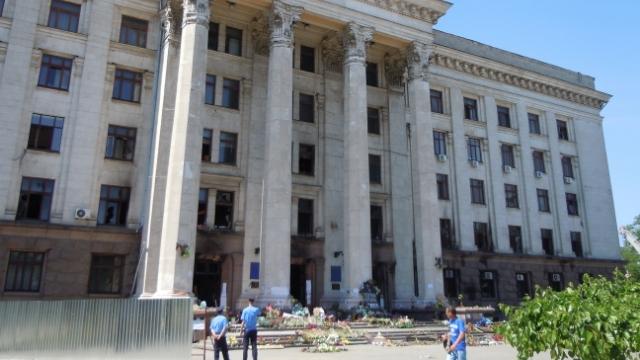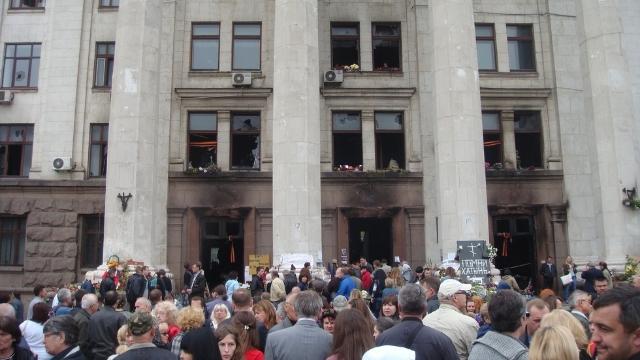The conclusion of the look at one of Putin's first war crimes in Ukraine. Part I is here.
From Bitter Winter
By Willy Fautré
“About 40 anti-Maidan activists died in Kulikovo Square on May 2, 2014.” But were they killed deliberately?
Article 2 of 2. Read article 1.

On May 2, 2014, a football match was to take place in Odessa at 5 pm between a local club, Chernomorets, and the Metalist team from Kharkov. Before the match, the fans of both clubs, local pro-Maidan activists and city residents (about 2,000 people in total) held a rally.
Paving the way to a predictable tragedy
3 pm was the time they had planned to hold a pro-Maidan rally in the center of Odessa.
Some anti-Maidan activists were allegedly fearing that the football fans would break up their protest camp on Kulikovo Square, situated about 2 km from the center of the city. They decided to hold their own rally, a few blocks from the other assembly point, and spread the message through social media networks to gather around 1.30 pm.
At 3.20 pm, during the march towards the stadium, the pro-Maidan rally was attacked near Greek Square by some 300 anti-Maidan protesters.
By 3.50 pm, law enforcement officers had formed a cordon separating the two sides but the clashes continued, with protesters throwing stones and stun grenades over the police officers. Later, firearms, air guns and Molotov cocktails were used, resulting in the first casualties.
At about 4.10 pm, the first victim received a fatal firearm injury.

Law enforcement officers were reported to have taken certain measures during the early phases of the clashes but later, it appeared that they made little, if any, effort to intervene and put an end to the violence. In addition to the impression of general passivity, video footage posted on the Internet gave rise to allegations of complicity between some policemen and the anti-Maidan protesters.
The clashes on and around Greek Square in the center of Odessa went on until about 7 pm. Six persons, including four pro-Maidan activists, died as a result of injuries and several dozens were quickly hospitalized.
At a certain point, the pro-Maidan activists prevailed in the clashes, and pursued the anti-Maidan opponents towards Kulikovo Square, about 2 km from the center. Their intention was to clear the place from the tents of the anti-Maidan activists picketing there for weeks.
A detailed chronology of events, almost minute by minute, with videos was established by the “May 2 Group” one year later.
The “May 2 Group” was created at the initiative of a number of Odessa journalists and various experts after the riots in order to investigate the tragic events. It included: journalists Sergei Dibrov, Tatiana Gerasimova, Vera Zaporozhets, Valeria Ivashkina, Yuri Tkachev, Leonid Shtekel, expert chemist Vladislav Balinsky, expert toxicologist Vladimir Sargsyan, expert on ballistics, weapons and ammunition, retired captain of the Ministry of Internal Affairs Yuri Mukan, retired lieutenant colonel of the Ministry of Internal Affairs Vladislav Serdyuk, public relations specialist Svetlana Podpalaya, video engineers Yuri Vesilyk and Pavel Palamarchuk, specialist in negotiating and conflict resolution Evgeny Peresypkin.
The working method of the “May 2 Group” was based on the analysis of open sources: a lot of video and photo material posted on the Internet, eyewitness accounts on social networks, forums and blogs, responses to information requests to various state and non-governmental institutions, as well as interviewing witnesses.
The basis of the investigation is the chronology of events restored with maximum accuracy, detail, and personalization. Responses to information requests, facts reported by witnesses and participants in the events, relatives of the victims and victims, insider information, expert conclusions complement and concretize the chronology.
The battle around and in the Trade Union House
In the meantime, some of the leaders of the anti-Maidan protesters in Kulikovo advised their followers there to leave the place and flee. Others, like Odessa Oblast council member Oleksiy Alba, told his people to retreat in the Trade Union House, a five-floor building facing the square and to barricade themselves in it. This was a wrong decision as they trapped themselves in the building.
At around 6.50 pm, anti-Maidan activists broke down the front door of the building and brought inside various materials, including boxes of Molotov cocktails and the products needed to prepare them. Using wooden pallets which had supported their tents, they blocked the entrances to the building from the inside and erected barricades all around to keep away the pro-Maidan activists.
Around 7.20 pm, pro-Maidan activists arrived at Kulikovo Square. They destroyed the tents of the anti-Maidan camp. The anti-Maidan protesters exchanged shots and Molotov cocktails with their opponents outside. Several attempts by the pro-Maidan protesters to storm the building proved to be unsuccessful although a few of them managed to enter the building through the back door.

At 7.31 pm, the dispatch center for the fire brigade was first called. It was repeatedly called after the first tents had been set on fire. Although the closest fire station was less than 5 minutes’ drive from Kulikovo, the first engines did not arrive until over 30 minutes later. An internal inquiry determined the time at 8.09 pm (exactly 38 minutes later). There was a delay of approximately 10 minutes between the first call and the order to send the first fire engine. The audio recording of the telephone calls to the dispatch center was later posted on the Internet.
At about 7.45 pm, a fire broke out in the Trade Union House. In its report, the “May 2 Group” stated “Forensic examinations subsequently indicated that the fire had started in five places, namely the lobby, on the staircase to the left and the right between the ground and first floors, in a room on the first floor and on the landing between the second and third floors. Other than the fire in the lobby, the fires could only have been started by the acts of those inside the building. The forensic reports did not find any evidence to suggest that the fire had been pre-planned. The closed doors and the chimney effect caused by the stairwell resulted in the rapid spread of the fire to the upper floors and a fast and extreme rise in the temperature inside the building.” There was also a lot of inflammable material in the building.
By 7.54 pm, the fire was reaching its peak and some of those in the building desperately tried to escape by jumping out of the windows on the upper floors. A number of them were killed in falling. Video footage on the Internet shows others being assaulted by pro-Maidan protesters outside the building after they had jumped. However, there is also footage showing pro-Maidan protesters creating makeshift ladders and platforms from the stage that had been erected for speakers on the square and using them to rescue dozens of anti-Maidan activists trapped in the building who were then evacuated to safe zones.
At 8.50 pm, the fire was finally extinguished: 330 people were then rescued and evacuated from the building. 31 people were first found to have died inside the Trade Union House and 8 more bodies were found within its curtilage. After the fire was extinguished, the police entered the building and arrested 63 anti-Maidan protesters who were still inside or on the roof.
According to official statistics,
- 208 persons (including 34 law enforcement officers, 6 of whom from firearm injuries) were injured
- 48 persons died (7 women and 41 men) in the May 2, 2014, incidents:
- 6 persons died as a result of firearm injuries received during the clashes in and around Greek Square in the center of the city
- 42 died as a result of the fire in the Trade Union House: 32 as a direct result of the fire and 8 died as a result of jumping or falling from a height.
No other violent cause of death by shooting or with other means was established.
Likewise, it was not established that any gas was present in the building, other than the gases produced by the fire.
There were no foreigners among the deceased, they were all Ukrainians.

The list of victims was posted and is available on the website of Human Rights Without Frontiers as I could establish it one month on the basis of my investigation in May 2014 in Odessa.
The May 2 events were the bloodiest civil conflict in Odessa since the pre-Bolshevik revolutionary raids on the city’s Jews and street fights in 1918.
Anti-Maidan activists attacked a police station to have their prisoners released
On May 4, two days after the tragedy, the police station where more than 100 people had been in custody was under siege by a group of anti-Maidan activists. Under threat of the crowd the police officers released 67 people they had been holding since the night of May 2.
The rally organized to release the detainees started with a small group of believers of the Ukrainian Orthodox Church (loyal to the Moscow Patriarchate) who moved away from a larger crowd that had gathered on that day at the burnt-out Trade Union building.
Bearing church banners and icons, they called for others to follow them to the city police station to demand the release of more than 100 people taken into detention as part of the investigation into the May 2 riots. More people soon joined the rally.
About 100 riot police blocked one end of the street outside the police station, but did not prevent anyone from walking along the pavement. They just stood by and watched as the surging crowd who began to break the windows of the police station with stones, and eventually stormed the gate into the yard.
Soon after, the detainees streamed out, greeted by shouts of “heroes!”
Dmitry Futedzhi, the acting Odessa Oblast police chief, who was harassed by the crowd, said the decision had been taken to release the detainees in order to keep the conflict under control. He also said the people detained in the station had been brought there for their own safety, after they had asked for help to escape the clashes in the center of Odessa.
It still remains unclear where the alleged order to release the detainees originated from but the Ukrainian government was furious about the Odessa police’s decision.

Conclusion
The anti-Maidan activists at Kulikovo were then part of that segment of Ukrainian society siding with pro-Russian President Yanukovych, overthrown by the Maidan revolution, and his friend Putin in Russia.
For President Putin who wanted to go on treating Ukraine as a vassal country thanks to rigged presidential and parliamentary elections, this was intolerable. That is why he shamefully instrumentalized the Odessa tragedy in his propaganda strategy and created a narrative that had nothing to do with the reality. After failing to keep Ukraine in Russia’s orbit, the occupation of Crimea and Donbass, and the destabilization attempts of other regions of the country, such as in Odessa in 2014, Putin has launched a hybrid war that for years has been prepared with fake news and lies.
Were the pro-Russia anti-Maidan activists killed by pro-Maidan activists in Kulikovo Square? No, the victims were not killed by firearms, sticks or bladed weapons, or burned alive.
They died because the police hierarchy had been unable, if not unwilling, to guarantee public order on the eve of a high-risk event and because a number of police officers were just spectators and passive accomplices of the clashes.
They died because the fire services dramatically failed to react to an emergency situation.
They died in a fire starting at several places inside the Trade Union House, unreachable from outside, in which they had entrenched themselves with Molotov cocktails to continue the fighting with the pro-Maidan activists, exposing themselves to counter-attacks with other Molotov cocktails.
They died because they were trapped in an infernal circle of incompetence and irresponsibility of the city public services.
Further reading: report of the Council of Europe’s independent investigation panel on the events of May 2, 2014, in Odessa, chaired by Sir Nicolas Bratza, a distinguished British lawyer and the former President of the European Court of Human Rights.
No comments:
Post a Comment
Comments are subject to deletion if they are not germane. I have no problem with a bit of colourful language, but blasphemy or depraved profanity will not be allowed. Attacks on the Catholic Faith will not be tolerated. Comments will be deleted that are republican (Yanks! Note the lower case 'r'!), attacks on the legitimacy of Pope Leo XIV as the Vicar of Christ, the legitimacy of the House of Windsor or of the claims of the Elder Line of the House of France, or attacks on the legitimacy of any of the currently ruling Houses of Europe.